|
|


About Us
Available Mi-Kis
Males
Females
Other Pets
In Memory Of
Breed Standard
Grooming Chart
Mi-Ki Breeders
Mi-Ki History

Abbas Little Mi-Kis Contact Information: 423/781-7399 or abbasmikis@gmail.com

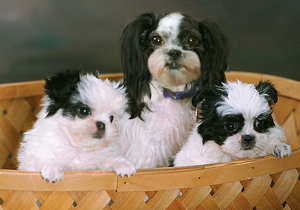
TOY GROUP
GENERAL INFORMATION AND APPEARANCE:
The Mi-Ki is a sweet tempered dog that acts neither dull nor ill tempered. The Mi-Ki is a devoted companion dog. The intelligence is notable in the Mi-Ki's alert, yet calm, expressive.
The Mi-Ki is a small, well balanced dog that is small boned, muscular, with winged or dropped ears and a long flowing coat topped by a full plumbed tail. A good specimen of the breed has dignity and proud head carriage.
The following description is that of the ideal Mi-Ki. Any deviation from this ideal is to be penalized to the extent of the deviation. Health, structural and movement faults can be common to all toy dogs are as undesirable in the Mi-Ki as in any other breed, even though they are not specifically mentioned herein. The Mi-Ki has a soft expression that reflects the characteristics of the Mi-Ki breed. The Mi-Ki is truly an elegant dog, with a graceful, stylish bearing.
Being a new breed, the consistency of type is not yet thoroughly established, but measurably on its way with a good number of dogs having the desired type. Through a well-structured and responsible breeding program, the ARBMR has a group of breeders that work together to consistently produce the ideal type.
SIZE AND PROPORTION:
Weight: Adult dogs, 1 year and older, are not to exceed 10 pounds. Smaller sized Mi-Kis are the most desirable, but never at the expense of balance, structure, and correct gait.
Fault: Over ten (10) pounds
Height: Adult dogs, 1 year and older, are not to exceed 10 inches at the withers. Adult dogs are not to exceed 10 pounds. However, type and breed characteristics are of greater importance.
Fault: Over ten (10) inches
Note: The Mi-Ki is slightly longer than tall when measured from the point of shoulder to point of buttocks and from withers to ground.
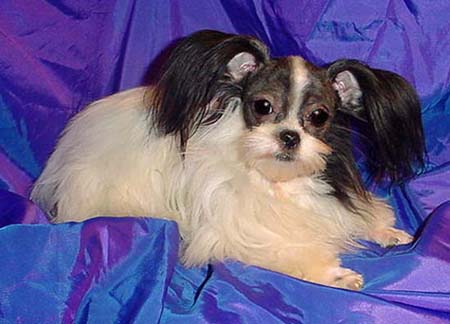 HEAD:
Head and Skull: The head is small, with a medium width and rounded in front and between the ears.
HEAD:
Head and Skull: The head is small, with a medium width and rounded in front and between the ears.
Fault: A large head that is not proportioned with the rest body. A domed skull
Stop: The stop (the region where the muzzle joins the skull) should be well defined at a 90-degree angle.
Fault: A stop that has less than a 90-degree angle is less desired.
Forehead: The forehead and face are smooth and free of wrinkles.
Fault: Flat or domed forehead.
Muzzle: The muzzle should be no longer than 1/4 of the length of the head from the base of the skull to the stop. The shape of the muzzle should be square with no wrinkles. The top of the muzzle is flat, and the bridge, in profile, is straight or only slightly arched. Explanation of the Muzzle see below
Fault: A muzzle longer than the formula. A thin or pointed muzzle, abruptly thinner than the head, tapering to the nose. Wrinkled muzzle. Pinched nostrils.

Nose: The nose should be of medium size, not pitched, and flat on top. Black is preferred, but can be self-colored on brown or lighter coated dogs. Must be black on white color coated dogs.
Fault: Color of nose other than black on a white color coated dog.
Bite: An even or slightly undershot bite is most desirable, but most definitely not overshot.
Fault: Overshot bite or an extremely undershot bite with teeth showing when mouth is closed.
Missing teeth or retained baby teeth at maturity.
Eyes: Large and round, set well apart, dark brown is most desirable, brown or ruby in brown or darker colored coats. Self-colored eye rims are acceptable in brown and light colored dogs.
Fault: Eyes and eye rims colored other than dark color on a dark or white color coated dog.
Ears: Most preferred ears should be set slightly below the crown of the skull and carried at such an angle that they wing out from the head. The hair on the ears should be feathered. A heavily coated ear that measurably wings out when excited or alert is acceptable.
Fault: Ears placed on top of head pointing up. Scant amount of hair on ears.
NECK, TOP LINE, BODY
Neck: The neck should be of medium length, never thick or too long. The neck is strong and well set on the shoulders and is long enough for proud head carriage.
Fault: An extremely long or too thick neck.
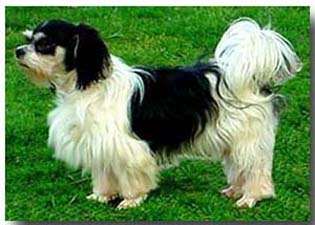
Top Line: Top Line (Back Line) level. The back is strong, and is level from just behind the withers to the croup. Firm shoulders.
Fault: Exceedingly long, roached or sagging back.
Body: The body should be square to slightly longer than the height.
Fault: Exceedingly long, roached or sagging back. Wide or barreled chest.
Tail: The tail is heavily plumed, sets high, and curved over the back
Fault: Low set tail. Scant plumage or straight tail.
Chest: The chest is full with the brisket reaching at least down to the elbows. The Mi-Ki is a dog of good substance that is determined by sprung ribs. The flank is well balanced. The chest is to be in proportion with the rest of the body.
Fault: Chest is not to be to wide, barreled, suck in, to narrow, or too deep.
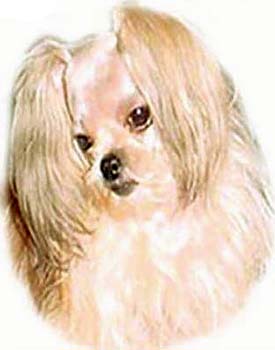
FOREQUARTERS, HINDQUARTERS AND GAIT:
Forequarters:
Forelegs: are to be straight, fine boned, and parallel to each other.
Shoulders: are slightly laid back.
Elbows: are set close to the body, lies directly below the highest point of the withers and they point directly to the rear. The distance from elbow to ground equals about half the dog's height.
Pasterns: are strong and slightly sloping.
Feet: are proportionate to the body in size and are straight to minutely set outward.
Toes: straight
Dewclaws: declaws do not have to be removed, but it is .
Fault: Bowlegged forelimbs, feet, sharply angled outward.
Hindquarters:
Hind legs: are muscular, fine boned and parallel to slightly angled outward when viewed from behind, but not excessively angled. Feet straight and toes same as on forefeet. Viewed from the side, the thighs should equal about half the dog's height in the rear. Stifles and hocks are bent and the line from hock to ground is perpendicular. Hocks are slightly let down. Hind feet are similar to the front feet. Dewclaws must be removed.
Fault: Hind legs excessively turned in or out. If dewclaws are present on hind legs.
Gait:
The Mi-Ki in motion has good reach, free flowing action, and when viewed from the front and rear, is straight and true. His gait is light, smooth and rhythmic. Forelegs and hind legs travel straight forward. When moving, a beautiful flowing coat is characteristic of the breed. Essential to good movement is the balance of correct front and rear assemblies.
Fault Any departure from the Standard is considered a fault.
COAT AND COLOR:
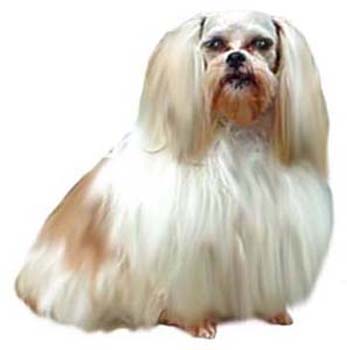
Coat: There are two coat types that are expectable, the long cottony or long silky coat. The cottony coat may be slightly wavy, but not curly. The silky/straighter coat is the more desirable coat. The coat covers entire body, hair on the face and muzzle can be long if allowed to grow, most Mi-Kis are groomed to keep the hair short on the head, neck, muzzle and feet. The backs of the legs are feathered all the way down. The Mi-Ki has hair not fur, with no undercoat making it hypoallergenic and non-shedding. The long coat hangs gracefully over the sides of the body and flows with movement of the dog.
Fault: A short coat, undercoat of any type and any coat other than silky or cottony/slightly wavy.
Color: All colors are permissible. Color is always secondary to type, structure, and soundness. All colors are permissible. i.e. Any solid color, or the colors can be blended, i.e. splashed, grizzle, in all colors; Black, blue, silver, red, brown, orange, tawny yellow, cream to pure white, etc. The rarest of combinations is a tri-color, being characterized by tan or red spots above the eyes, and on both cheeks and the solid colors.
TEMPERAMENT:
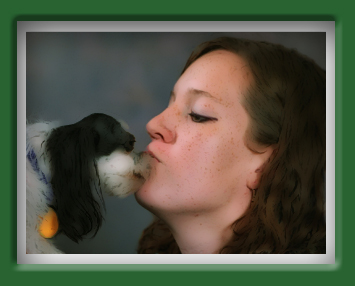
The Mi-Ki is an adaptable, trusting, affectionate, playful, alert, friendly, sensitive, non-aggressive and intelligent dog. Their purpose is to serve man as a faithful companion. They are wonderful with children and other animals. Being neither shy nor aggressive they are among the gentlest mannered of all the toy breeds. The Mi-Ki is not a ‘yippy’ dog and is responsive to those it knows and loves. They are not known to be reserved with strangers, or in new situations, however they will alert the household when something is amiss. They continue to be excellent therapy dogs. They are a gay little dog with no tendency towards nervousness or shyness. These characteristics are the most important characteristics of the breed.
Fault: Excessive shyness
STATEMENTS ON FAULTS
The seriousness, with which the fault should be regarded, should be in exact proportion to the degree of he fault under consideration.
Disqualifications for Conformation Shows
1. Male dogs that do not have two apparently normal testicles fully descended into the scrotum.
2. Neutered/Spayed dogs
3. Unshaved head, feet and no topknots or any other cut.
4. Bad temper and meanness are not to be tolerated and are to be severely penalized as to remove the dog from competition.
5. More than 10 inches in height at the shoulder.
6. Any dog, lame, limping, deaf or blind.
MI-KI'S MUZZLE
Explanation of the Muzzle:
The muzzle should be no longer than 1/4 of the length of the head from the base of the skull to the stop. To measure correctly use a soft measuring tape. It should be pressed to the skull, not loose or you may get the wrong measurement.
For Example: The dogs’ measurement is 4 inches from the base of the skull to the stop. Then 1/4 of the 4 inches would be1 inch for that muzzle length. Now measure from the "stop" to the "tip of the nose" that Mi-Kis perfect muzzle length would be 1 inch. To view a picture of the measurement refer the Guide to Measuring Your Mi-Ki. The shape of the muzzle should be square with no wrinkles. The stop (region where muzzle joins the skull) should be well defined at a 90-degree angle.
· An example of a short muzzle, which gives a pushed in look. Sometimes, dogs with this muzzle length have a pronounced under bite and/or the typical wrinkle as found in the Japanese Chin. There is a tendency of a compromised respiratory ability with the very short muzzle dog, especially as the dog ages. This type of dog should not be bred to a dog of the same conformation, but to a dog with a medium length muzzle.
· An example of the most desirable muzzle length. Dogs with a medium length muzzle usually have a bite that is even to slightly undershot. If this type of dog's under bite in the excessive range, it should be bred to a dog with the same medium length muzzle, but with an even bite, definitely not to a dog of similar bite.
| | |